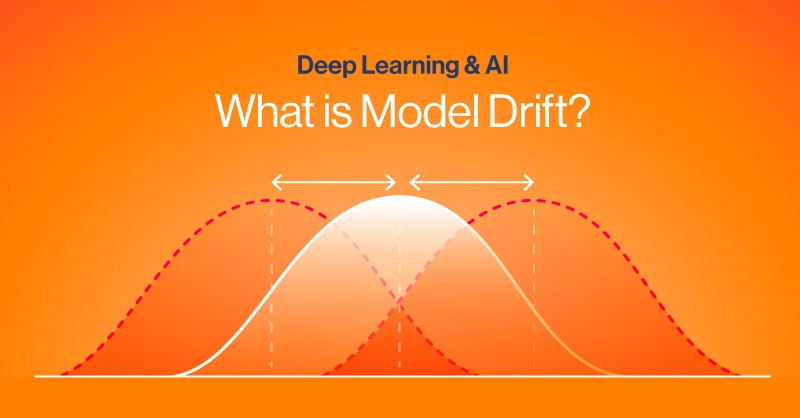Introduction
Over time, the environment that the model was trained in and the data it was trained on changes. Model drift refers to the shift that occurs due to changes in data, environment, and their relationship to the overall goal, resulting in inapplicable predictions and flawed results.
Consider a LLM chatbot for a business; when processes change, products get introduced, and products get phased out, the chatbot needs to be brought up to speed before helping customers solve problems. Otherwise, it can provide incorrect answers to problems it has never seen before.
Whether you're fine-tuning an LLM, deploying a recommendation engine, or running a predictive model in a business pipeline, responding to model drift is critical. This blog offers a high-level overview of what causes drift, how to detect it, and how to build AI systems that can adapt over time.
What’s at Risk When You Ignore Model Drift?
If left unmonitored, model drift can lead to serious consequences, such as misinformed business decisions and possibly regulatory risks in sensitive sectors like finance or healthcare. For example, a loan approval model that drifts may begin unfairly rejecting qualified applicants, or a medical triage tool might misclassify patient risk levels.
In high-stakes environments, small shifts in data or behavior can compound over time, resulting in costly mistakes.

What Causes Model Drift?
Model drift occurs when the data your model sees in production no longer reflects the data it was trained on. This can happen in two key ways:
- Concept drift: The relationship between input features and the target variable changes. For example, a fraud detection model trained on last year’s patterns may miss new fraud tactics emerging today.
- Data drift: The input data distribution itself shifts. Imagine a customer segmentation model built on web traffic from desktop users—if mobile usage suddenly spikes, the model may become less effective.
Common causes of model drift include:
- Seasonal trends or market fluctuations
- Shifts in customer behavior or preferences
- Major external events, such as economic changes or global disruptions
- Updates or errors in data pipelines and sources
These shifts are often subtle and gradual, which makes them easy to miss until performance drops. That’s why understanding the root causes of drift is key to maintaining effective AI systems.
How to Detect Model Drift
Detecting model drift early helps you avoid downstream issues like inaccurate predictions or business decisions based on outdated insights. Here are some common signs your model may be drifting:
- A drop in key performance metrics (e.g. accuracy, precision, recall)
- An increase in prediction errors or unusual outputs
- A noticeable difference between training data and live input distributions
To catch these issues, you’ll need some form of monitoring in place. Here are a few basic techniques:
- Track model performance over time: Log metrics after each batch of predictions and watch for trends.
- Compare feature distributions: Use statistical tests or visualizations to see if input data has shifted.
- Set alerts for threshold breaches: Create simple rules that trigger when performance drops below an acceptable level.
Some tools make drift monitoring easier such as:
- MLflow and Weights & Biases for logging and experimentation
- Evidently AI, Fiddler, and WhyLabs for detecting drift and visualizing data changes
- Another useful strategy is to maintain a baseline model for ongoing comparison. If performance begins to deviate from the baseline under similar conditions, that’s a strong signal drift is occurring. When labels are available, tracking the difference between predicted and actual values (ground truth) can help validate these signals.
While these don’t eliminate drift, they give you the visibility needed to act before it becomes a serious issue.
How to Prevent and Respond to Drift
While you can’t stop model drift from happening, you can build systems that respond to it effectively. Here are a few ways to stay ahead of it:
- Retrain your models regularly: Use updated data from production to refresh your models. Set a cadence based on how quickly your data environment changes.
- Automate retraining pipelines: Build workflows that trigger retraining when data shifts or performance drops below a certain threshold. Tools like Airflow or Kubeflow can help automate this process.
- Use shadow models: Run updated models alongside your production model to compare outputs without impacting users. This helps validate new models before full deployment.
- Continuously validate incoming data: Check for schema mismatches, missing values, or unexpected distributions before the data hits your model.
- Make monitoring part of deployment: Don’t treat it as an afterthought. Drift detection should be built into your MLOps stack from day one.
By taking a proactive approach, you reduce the chances of degraded performance and make your AI systems more resilient to change.
FAQ about Model Drift
Is model drift always bad?
Not always. It can reveal changes in user behavior or market trends. The key is whether your model is still making relevant predictions.
How often should I check for drift?
It depends on your use case, but weekly or monthly checks are common in active production systems.
Can data drift happen without concept drift?
Yes. Input data can shift even if the relationship to the target stays the same, but it still impacts model performance.
Conclusion
Model drift is a natural part of working with real-world AI systems. As data and user behavior evolve, your models need to adapt. The good news is that with the right monitoring and maintenance strategy, you can catch drift early and respond before it impacts performance.
For entry- and mid-level AI developers, the key takeaway is simple: build with change in mind. Incorporate drift detection, automate retraining where possible, and make sure your deployment process includes visibility into how your model behaves over time.
Want to build AI systems that stay accurate and reliable? Explore SabrePC’s Deep Learning and AI Servers or contact us to learn how we can help you monitor and manage model drift with confidence.


